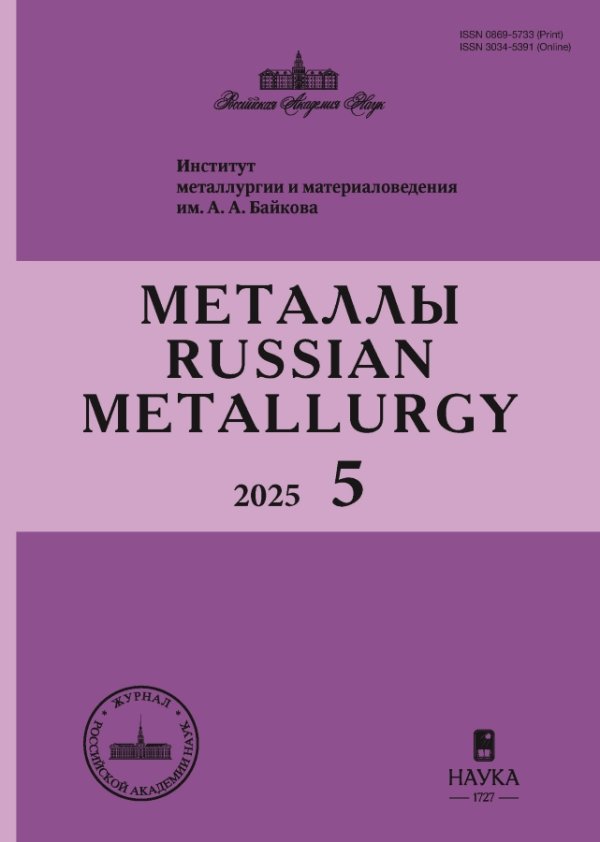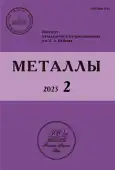No 2 (2023)
Articles
DEVELOPMENT AND IMPLEMENTATION OF AN EFFECTIVE METHOD FOR MANAGING SELENIUM DISTRIBUTION IN THE TECHNOLOGY OF SULFATE LEACHING OF FUSED PRODUCTS AT "THE NORILSK NICKEL HARJAVALTA OY" ENTERPRISE
Abstract
The nickel refining company "Norilsk Nickel Harjavalta Oy" (NNH) produces three main types of nickel products: cathode nickel, nickel powders (briquettes), nickel salts. The decisive role in achieving high performance and guaranteed quality the nature of the impurities distribution and their behavior control, in particular selenium, plays a role in nickel products. Selenium has a sharply negative effect on the process of obtaining a cathode nickel base. At elevated concentrations in nickel-cobalt solution, this impurity makes it impossible to stable obtain commercial nickel cathodes. The study of the selenium behavior patterns in the processing circuit of metallurgical intermediates, such as feinstein and stein of electric slag-cleaning furnace (ESCF), made it possible to make the necessary changes to the technological scheme of the NNH leaching shop and to clarify the operating parameters of the main operations. A hypothesis is proposed about the possible mechanism of the effect of metallized fraction (alloy) contained in the feedstock on the process of reducing Se6+ to Se4+. The experiments performed confirmed the direct dependence of the selenium deposition degree from the solution to the solid precipitate from the alloy content in the feedstock. It has been established that by combining the applied ESCF matte with feinstein and/or nickel concentrate (NC) from feinstein separation, it is possible to effectively control the distribution of selenium in NNH technology, preventing its critical concentrations in nickel catholyte. Based on the research results, a two-flow scheme for processing processed products has been implemented, in which it is envisaged to use a combination of NC and products with a high content of metallized fraction. This method allowed to minimize the concentration of selenium in nickel catholyte.
 3-13
3-13


INFLUENCE OF DEFORMATION GUIDANCE CONDITIONS ON CHARACTERISTICS OF Ni49,5Ti48Hf2,5 ALLOY WITH HIGH-TEMPERATURE SHAPE MEMORY EFFECT
Abstract
Complex studies of the properties of Ni49,5Ti48Hf2,5 alloy featuring high-temperature shape memory effect were carried out on samples made of 2,34 mm-thick strip after high-temperature annealing in vacuum (850 ºС, 1 h). Data on element, phase compositions and structure state was obtained. Results of studies of phase transition temperatures, mechanical and thermomechanical characteristics of the alloy are given. According to the results of studying the local phase composition of alloy samples, it was found that the main matrix of samples is formed by solid solution of Ti, Ni, Hf elements. When analyzing diffraction patterns, it was found that the main phase of samples is titanium nickelide in the low-temperature martensitic state TiNi (B19`) with a monoclinically distorted orthorhombic crystal lattice. It was found that the best average values of the shape memory characteristics εSME = 4,4 % and ηSME = 53 % were obtained for alloy samples with a previously induced total deformation of eо = 11 % in the temperature range tD=(–5 ÷ 23) ºС and deformation rate ε ≈ 2,8·10–3 s–1. The average values of temperatures of the start and the end of the main form recovery are Аs SME = 133 ºС, Аf SME = 149 ºС. These thermomechanical characteristics are suitable for alloy selected to create safety devices such as devices of pushing type.
 14-25
14-25


THE ROTARY FORGING EFFECT ON THE STRUCTURE AND PROPERTIES OF MAGNESIUM ALLOYS OF THE Mg-Y-Gd-Zr SYSTEM
Abstract
The study results of the structure and mechanical properties of magnesium alloys obtained by rotary forging, similar in composition to the IMB7-1 alloy of the Mg-Y-Gd-Zr system, are presented. Mechanical properties were determined after rotary forging and after rotary forging with subsequent aging at 200 °C for up to 64 hours. The alloys were aged both immediately after rotary forging and after homogenization at 515 °C of the deformed alloys obtained. It is established that rotary forging contributes to the hardening of the studied alloys as a result of grain grinding and intensive twinning. Aging carried out after rotary forging leads to additional hardening of alloys as a result of the decomposition of supersaturated magnesium solid solution. Annealing after rotary forging increases the grain size in the studied alloys due to collective recrystallization and thereby reduces the strength properties of the alloys.
 26-31
26-31


INTERACTION OF EXOGENOUS NANOPHASES OF ZIRCONIUM OXIDE WITH TIN IN NICKEL-BASE SUPERALLOYS
Abstract
The processes of interaction of exogenous nanoparticles of refractory compounds ZrO2 with model nickel-base superalloys, containing tin, were studied. It was shown that, under laboratory conditions, the degree of tin removal in the metal after the introduction of ZrO2 nanoparticles depended on the time of isothermal holding and amounted to 11–18 rel.%. The content of various forms of zirconium after the experiments was determined and it was shown that the amount of ZrO2 removed from the metal to the interface of the phases Me-(refractory, slag, gas) was on average 50 rel.%.
 32-38
32-38


CRITICAL CURRENT DENSITIES IN MAGNETIC SUPERCONDUCTORS Dy1–xErxRh3,8Ru0,2B4 (x=0,2;0,4)
Abstract
Rhodium borides of the compositions Dy0,8Er0,2Rh3,8Ru0,2B4 and Dy0,6Er0,4Rh3,8Ru0,2B4 were synthesized on the basis of the compound DyRh3,8Ru0,2B4 by partial substitution of dysprosium (Dy) with erbium (Er) with a LuRu4B4 type structure. The dependences of χ-1(T), M(B) and Bc2(T) were studied for these compounds. It is established that the compounds Dy0,8Er0,2Rh3,8Ru0,2B4 and Dy0,6Er0,4Rh3,8Ru0,2B4 are magnetic superconductors with a critical temperature Tc ≈ 5.1 and 5.8 K, respectively; at T ≈ 3 K the magnetic subsystem of these compounds goes into the antiferromagnetic state. Based on measurements of the magnetic moment from the field (M(B)) for samples of compounds Dy0,8Er0,2Rh3,8Ru0,2B4 and Dy0,6Er0,4Rh3,8Ru0,2B4, using the Bean model, dependences on the field of the critical current density jc(B) and the reduced pinning force fp(h) are obtained. The value of jc in the studied samples did not exceed 400 A/cm2 at T ≈ 2 K. It is established that in the case of magnetic superconductors with antiferromagnetic ordering (Dy0,8Er0,2Rh3,8Ru0,2B4 and Dy0,6Er0,4Rh3,8Ru0,2B4) at h > 0.4 there is a significant deviation from the law of similarity.
 39-44
39-44


SYNTHESIS OF TiN-Cu NANOCOMPOSITE COATINGS BASED ON THE PRINCIPLE OF COUPLING PROCESSES OF VACUUM-ARC EVAPORATION, MAGNETRON SPUTTERING AND ION BEAM SPUTTERING
Abstract
Superhard TiN-Cu composite coatings have been obtained, the synthesis of which is based on the principle of coupling the operating modes of a vacuum arc evaporator a planar magnetron and a plasma ion source. The constitution, structure and properties of TiN-Cu composite coating do not depend on the type of hybrid methods of their synthesis. It is shown that the coatings have a characteristic homogeneous globular structure with crystallite sizes in the range of 20-50 nm and are textured along the plane (111). Copper does not form its own crystalline phase and is not in the crystal lattice of other phases, it is located at the boundaries of crystallites in an amorphous or X-ray amorphous state. The copper content throughout the coating profile is 5-10 at.%. The microhardness of the coatings is 38-42 GPa.
 45-47
45-47


THE FORMATION FEATURES OF PIPES STRENGTH CHARACTERISTICS MADE OF MASS GRADES OF AUSTENITIC STAINLESS STEELS AT ROOM AND ELEVATED TEMPERATURES
Abstract
As part of the research on the development of a new standard for welded and seamless stainless steel pipes, the microstructure, phase composition and mechanical properties in the temperature range of 20-650 °C of pipe samples from austenitic chromium-nickel steels of the Fe-18Cr-10Ni family were evaluated. Significant spread of mechanical characteristics is shown, a quantitative assessment of the contribution of various hardening factors is carried out. It is noted that grain size and solid-solution hardening with carbon, nitrogen or titanium have the most significant effect on mechanical properties, providing up to 45% of the yield strength of steel. It is established that the temperature dependence of the tensile strength is determined by the resistance to the formation of deformation martensite and the intensity of the action of dynamic deformation aging.
 48-58
48-58


MICRO-ALLOYED MOLYBDENUM ALLOYS FOR THE CREATION OF SURFACE-IONIZATION EMITTERS
Abstract
Molybdenum-based alloys with different surface-ionization properties for thermal emitters have been developed. The morphology of the oxidized alloys surface is investigated, a qualitative analysis of the formed oxides is carried out. The possibility of using these alloys to create multisensory amine sensors is shown.
 59-63
59-63


CALCULATED ESTIMATION OF NITROGEN SOLUBILITY AND PHASE COMPOSITION OF STEEL BASED ON Fe-13% Cr WITH ITS ADDITIONAL ALLOYING (Mn, Mo, V, Nb)
Abstract
Estimates of the nitrogen solubility in model steels of various compositions based on Fe-13%Cr with additional alloying (a small amount from hundredths of a percent to 1.5%) with elements (Mn, Mo, V, Nb) that increase the solubility of nitrogen in iron-based solid solutions are calculated. 60 variants of compositions were studied. Based on previously obtained own experimental data for nitrogen-containing steels with a content of 16%Cr-5%Ni-Nb for martensitic steel, a preliminary assessment of the composition stability coefficient of nitrogen used in the calculations of its (nitrogen) solubility was carried out. The resulting value of the composition stability coefficient is lower than for austenitic steels. For steels of all composition variants with calculated nitrogen content and different content of additional alloying elements (Mn, Mo, V, Nb), the phase composition was estimated using a modified Scheffler—Delong diagram and a nonequilibrium Potak—Sagalevich diagram for steel, which processed on solid solution. It is shown, among other things, that all compositions of Fe-13%Cr-Mn, Mo, V, Nb with a low carbon content (0.03—0.05%) with the maximum calculated solubility of nitrogen in the metal are in the martensitic-ferritic region. By calculation, the temperature of the martensitic transformation beginning was obtained using the empirical Finkler—Schirra formula and a correlation was established between the temperature of the martensitic transformation beginning and the Niequivalent/Crequivalent ratio (chromium and nickel equivalents calculated using formulas for the modified Scheffler—Delong diagram).
 64-77
64-77


INVESTIGATION OF A TWO-STAGE LEACHING METHOD OF WEST AFRICAN BAUXITE
Abstract
A two-stage method of leaching west african bauxite is considered. Optimal conditions of bauxite leaching under atmospheric and autoclave conditions have been determined. The dependences of the bauxite pulp deposition on time with the addition of different doses of flocculant are constructed.
 78-84
78-84


INVESTIGATION OF EUDIALYTE CONCENTRATE DECOMPOSITION BY SORPTION CONVERSION IN NITRIC AND HYDROCHLORIC ACID MEDIA
Abstract
The influence of the sorption conversion conditions for the eudialyte concentrate in low-concentration nitric and hydrochloric acid solutions (concentration and consumption of acid, temperature and duration of the process, sorbent consumption) on the valuable metals extraction efficiency (zirconium, hafnium, niobium, rare earth elements, titanium, manganese) into sulphocationite was studied. Optimal conditions for the process have been determined. It has been shown that sorption conversion in nitric acid solutions is more effective for separating valuable components from the silica component of eudialyte concentrate compared to both the traditional method decomposition by nitric acid and the method of sorption conversion in sulfuric and hydrochloric acid environments. The reasons for the loss of valuable metals and the behavior of natural radionuclides are discussed.
 85-92
85-92


OXIDATION KINETICS OF LITHIUM-MODIFIED LEAD BABBIT BLI (PbSb15Sn10Li) IN THE SOLID STATE
Abstract
The study results of the lithium-modified lead babbitt BLi (PbSb15Sn10Li) oxidation kinetics of in the temperature range 373–473 K are considered. The resulting oxidation products of the alloys are identified, and the microstructure of the alloys is studied. The experiments were carried out by the thermogravimetric method in air at atmospheric pressure in the temperature range 373–473 K. It was established that the oxidation process in the entire studied range temperatures can be described with high accuracy by a polynomial of the fourth degree. The experiments noted a periodic change in the oxidation rate over time. The kinetic and energy parameters of the alloy oxidation process have been determined. It has been established that in the temperature range of 373–473 K, lithium additives increase the oxidation of lead babbitt BLi (PbSb15Sn10Li). It has also been shown that the addition of an alloying component significantly grinds its microstructure. Using X-ray phase analysis, it was revealed that the oxidation products of alloys consist of oxides, including PbO, Li2SnO3, Pb2Sb2O7, Sb2O3, Pb3O4, Sb2O4.
 93-99
93-99












